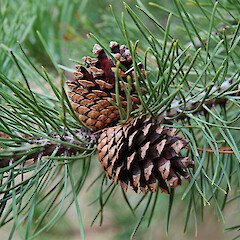Pinus contorta
Common name
lodgepole pine
Family
Pinaceae
Flora category
Vascular – Exotic
Structural class
Trees & Shrubs - Gymnosperms
NVS code
The National Vegetation Survey (NVS) Databank is a physical archive and electronic databank containing records of over 94,000 vegetation survey plots - including data from over 19,000 permanent plots. NVS maintains a standard set of species code abbreviations that correspond to standard scientific plant names from the Ngä Tipu o Aotearoa - New Zealand Plants database.
PINCON
Conservation status
Not applicable
Habitat
Terrestrial. A plant of montane and subalpine habitats. The plant grows in sites with low fertility. A plant of tussocklands. Areas at risk from invasion by the plant are indigenous and introduced scrub, tussock grassland at medium to high elevation, pasture and open forest.
Wetland plant indicator status rating
Information derived from the revised national wetland plant list prepared to assist councils in delineating and monitoring wetlands (Clarkson et al., 2021 Manaaki Whenua – Landcare Research Contract Report LC3975 for Hawke’s Bay Regional Council). The national plant list categorises plants by the extent to which they are found in wetlands and not ‘drylands’. The indicator status ratings are OBL (obligate wetland), FACW (facultative wetland), FAC (facultative), FACU (facultative upland), and UPL (obligate upland). If you have suggestions for the Wetland Indicator Status Rating, please contact: [Enable JavaScript to view protected content]
FACU: Facultative Upland
Occasionally is a hydrophyte but usually occurs in uplands (non-wetlands).
Detailed description
Large shrub or small to medium-sized tree (sometimes large in cultivation); habit erect or spreading. Branches straight or somewhat twisted. Bark reddish-brown, grey on surface, fissured and forming small plates. Shoots brown, glabrous. Buds cylindric or cylindric-ovoid, purplish-brown, strongly resinous; scales tightly appressed. Leaves 2 per fascicle, 3.5–6.5 cm × 0.8–1.5 mm, sometimes twisted, usually pointed forward, generally yellowish-green; resin canals median; sheath very short after first year. Male strobili 5–15mm long, cylindric or broadly cylindric. Conelets sessile; scales aristate. Mature cones long-persistent, often not opening until long after maturity, subsessile, usually directed downwards or backwards, 3–6 × 2–3.5cm, generally broad-ovoid; base asymmetric; apophyses shining yellowish-brown or brown before maturity, convex; umbo with short, slender, occasionally deciduous prickle. Seed wing asymmetric but almost oblong, c. 1 cm long. (Webb et. al., 1988)
Similar taxa
The combination of short needles in pairs, and small cones with a spikes on the cone scales distinguishes Pinus contorta from other naturalised Pinus species in New Zealand.
Flower colours
No flowers
Life cycle
Perennial. 15,000 viable seeds/year are produced by a 12 year old, 5 m tree. Germination of seeds after 4 years (in dry storage at 4°C will last 10–20 years). Prolific quantities of viable seed is produced. Trees are precocious and recorded as coning at 3 years old. Seed is dispersed by wind that are dispersed over many kilometres.
Year naturalised
1957
Origin
Rocky mountains, N.W. America
Reason for introduction
Agricultural (to stabilise high country pasture which were eroding due to excessive burning and high stocking rates and impacts of rabbits).
Tolerances
The plant is tolerant to drought and frost (once established) and is slightly tolerant to poor drainage. The plant will not establish in dense forest but is tolerant to partial shade. Regrowth occurs after physical damage and grazing unless all foliage is removed. Trees larger than 2 m can withstand fire, a hot fire will kill seed.
National Pest Plant Accord species
This plant is listed in the 2020 National Pest Plant Accord. The National Pest Plant Accord (NPPA) is an agreement to prevent the sale and/or distribution of specified pest plants where either formal or casual horticultural trade is the most significant way of spreading the plant in New Zealand. For up to date information and an electronic copy of the 2020 Pest Plant Accord manual (including plant information and images) visit the MPI website.
Environmental pest species
Pinus contorta is the most vigorous spreading conifer species in New Zealand and threatens landscape values, biodiversity and farming productivity by out-competing pasture areas and forming dense stands, even above the natural tree-line. For these reasons, it is the most targeted “pest” conifer species in New Zealand, as shown in Regional Pest Management Strategies. It is banned from sale, propagation and distribution. See also the National Wilding Conifer Control Strategy produced by the Ministry of Primary Industries.
The National Wilding Conifer Control Programme team at Biosecurity New Zealand, a branch of Ministry for Primary Industries, has produced a wilding conifer quick ID guide.





















